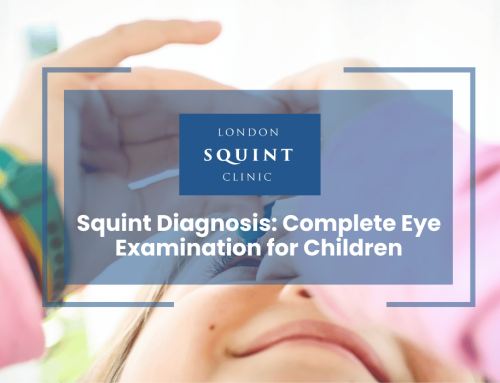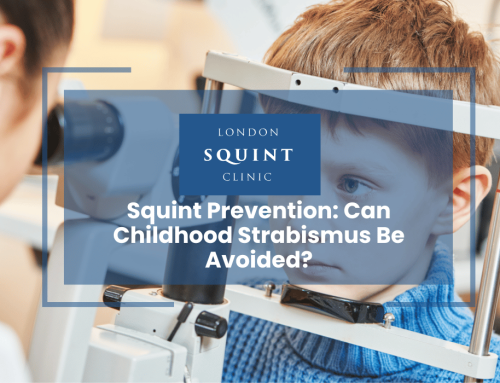Squint Surgery Alternatives: Modern Treatment Options
Essential Insights: Non-Surgical Squint Management
- Surgery isn’t always necessary for childhood strabismus—non-invasive alternatives like orthoptic exercises, corrective glasses, and vision therapy can be effective for certain types of squint.
- Botulinum toxin (Botox) injections offer a minimally invasive option that temporarily weakens overactive eye muscles, potentially providing long-term benefits in 50-70% of carefully selected pediatric cases.
- Vision therapy leverages neuroplasticity through structured eye exercises, showing particular effectiveness for intermittent exotropia and convergence insufficiency.
- Prismatic glasses can immediately improve functional vision by bending light to compensate for eye misalignment, offering relief without surgical intervention.
- Treatment selection should follow comprehensive assessment of the squint type, severity, and child’s age, often beginning with conservative approaches before considering more invasive options.
Table of Contents
- Understanding Squint: When Surgery Isn’t the Only Answer
- Non-Surgical Approaches to Treating Childhood Strabismus
- Botox for Strabismus: How This Alternative Treatment Works
- Vision Therapy: Exercises to Improve Eye Alignment
- Prismatic Glasses and Optical Solutions for Squint
- Is Botox Effective for Long-Term Squint Management?
- Choosing the Right Squint Treatment for Your Child
Understanding Squint: When Surgery Isn’t the Only Answer
Squint (strabismus) affects approximately 2-4% of children in the UK, causing one eye to look in a different direction than the other. While surgical intervention has traditionally been considered the definitive treatment for persistent squint, modern ophthalmology now recognises that surgery isn’t always necessary or the most appropriate first-line approach.
The decision to pursue squint surgery alternatives depends on several factors, including the type of squint (convergent, divergent, or vertical), its cause, severity, and the child’s age. Accommodative esotropia, for instance, often responds well to corrective glasses without surgical intervention. Similarly, intermittent squints may benefit from conservative management before considering surgery.
Modern squint therapy approaches consider the neurological aspects of eye alignment alongside the mechanical factors. This holistic understanding has led to the development of innovative strabismus treatments that can either delay the need for surgery or eliminate it entirely in select cases. For parents concerned about subjecting their child to an operation, these non-invasive eye alignment options provide welcome alternatives that can be equally effective for certain types of strabismus.
Non-Surgical Approaches to Treating Childhood Strabismus
Conservative squint management encompasses several evidence-based approaches that can effectively address childhood strabismus without surgical intervention. These methods are particularly valuable during the critical period of visual development, typically within the first 8-10 years of life.
Orthoptic treatment forms the cornerstone of non-surgical intervention. Orthoptists specialise in diagnosing and treating eye movement disorders and binocular vision problems. They employ various techniques to strengthen eye muscles, improve coordination, and enhance binocular vision. These exercises are customised based on the specific type and severity of the squint.
For children with accommodative esotropia (inward-turning eyes related to focusing efforts), prescription glasses can effectively straighten the eyes by correcting the underlying refractive error. This approach addresses the root cause rather than just the visible misalignment. In some cases, bifocal lenses may be prescribed to provide additional support for near vision tasks.
Occlusion therapy (patching) or Bangerter filters may be recommended when squint is accompanied by amblyopia (lazy eye). By temporarily covering or reducing vision in the stronger eye, these treatments encourage the weaker eye to work harder, potentially improving alignment as visual acuity equalises between both eyes.
These pediatric strabismus options often work best when implemented early, highlighting the importance of comprehensive eye examinations for children showing any signs of eye misalignment.
Botox for Strabismus: How This Alternative Treatment Works
Botulinum toxin (Botox) injections represent one of the most significant minimally invasive eye treatments for strabismus developed in recent decades. This innovative approach works on a fundamentally different principle than traditional surgery, offering a less invasive alternative with shorter recovery time.
Botox strabismus treatment involves injecting small amounts of botulinum toxin directly into specific eye muscles. The toxin temporarily weakens the overactive muscle that is pulling the eye in the wrong direction. As this muscle’s strength decreases, the opposing muscle can work more effectively, potentially improving eye alignment. The procedure is typically performed under local anaesthesia in adults or brief general anaesthesia in children.
This treatment is particularly useful in several scenarios: as a diagnostic tool to predict surgical outcomes, for small-angle deviations, in cases where surgery is contraindicated, and for temporary relief of diplopia (double vision). It can also be effective for acute onset sixth nerve palsy, where the lateral rectus muscle is weakened, causing the eye to turn inward.
The effects of Botox typically last 3-6 months, during which time the brain may adapt to the new eye position. In some patients, particularly children, a single injection can lead to long-term improvement as the visual system recalibrates during this window of altered muscle balance. For others, repeated injections may be necessary to maintain the beneficial effect.
Vision Therapy: Exercises to Improve Eye Alignment
Vision therapy represents a structured programme of eye muscle exercises and visual activities designed to improve eye coordination, focusing abilities, and visual processing. Unlike passive treatments, vision therapy actively engages the brain’s neuroplasticity to enhance the eye-brain connection, potentially improving alignment issues without surgery.
For certain types of strabismus, particularly intermittent exotropia (outward eye turn) and convergence insufficiency (difficulty keeping eyes aligned for near tasks), vision therapy effectiveness has been demonstrated in clinical studies. The therapy typically involves weekly in-office sessions with a trained orthoptist or optometrist, complemented by daily home exercises.
Common vision therapy techniques include:
- Pencil push-ups and convergence exercises to strengthen the ability to turn eyes inward
- Brock string activities to develop awareness of eye position and improve fusion
- Computer-based vergence and tracking programmes that gradually increase in difficulty
- Stereogram cards to enhance depth perception and binocular vision
- Balance board activities that integrate visual skills with whole-body coordination
Childhood eye alignment therapy through vision exercises works best when started early and requires consistent effort and compliance. While not suitable for all types of strabismus (particularly large-angle or constant deviations), it can be remarkably effective for functional vision problems and certain forms of intermittent squint.
Prismatic Glasses and Optical Solutions for Squint
Prismatic correction offers a non-surgical approach to managing strabismus through specialised optical technology. Unlike standard corrective lenses that primarily address refractive errors, prism lenses bend light before it enters the eye, effectively shifting images to compensate for eye misalignment.
For patients with smaller-angle deviations or those seeking temporary relief from diplopia (double vision), prismatic glasses can provide immediate functional improvement. The prism component can be incorporated into regular prescription lenses as a permanent feature or applied as temporary Fresnel prisms—thin, flexible plastic sheets attached to existing glasses.
The prismatic power is measured in prism dioptres and prescribed based on the direction and magnitude of the squint. For example, base-out prisms help with esotropia (inward turn), while base-in prisms assist with exotropia (outward turn). Vertical misalignments can be addressed with base-up or base-down configurations.
Beyond standard prisms, other optical solutions for squint management include:
- Bifocal or progressive lenses for accommodative esotropia
- Specially designed contact lenses with prismatic elements
- Occluding filters or fogging lenses to manage diplopia
- Sector occlusion for specific gaze positions
While prismatic correction doesn’t cure the underlying muscle imbalance, it can significantly improve visual comfort and function, particularly in adults with acquired strabismus or children for whom surgery is not immediately indicated.
Is Botox Effective for Long-Term Squint Management?
The efficacy of Botox as a long-term solution for strabismus management varies considerably depending on the specific condition being treated. Clinical evidence suggests that botulinum toxin injections can provide lasting benefits in select cases, though results differ between adult and paediatric populations.
For acute-onset strabismus, particularly sixth nerve palsy, Botox has shown impressive long-term success rates. Studies indicate that approximately 50-60% of patients with recent-onset sixth nerve palsy achieve permanent alignment after a single injection. The temporary weakening of the antagonist muscle allows time for natural recovery of the affected nerve, potentially eliminating the need for surgical intervention.
In children with acquired esotropia, Botox can be particularly effective when administered early. The temporary alignment created by the injection gives the developing visual system an opportunity to establish binocular connections that may persist even after the pharmacological effect has worn off. Success rates of 50-70% for permanent correction have been reported in carefully selected paediatric cases.
For adults with long-standing strabismus, Botox typically serves as a temporary measure rather than a permanent solution. Most patients require repeated injections every 3-6 months to maintain alignment. However, this approach may still be preferable to surgery for those with medical contraindications or who wish to avoid more invasive procedures.
Factors that influence long-term effectiveness include the cause and duration of the squint, previous treatments, the presence of amblyopia, and the patient’s age. Consultation with a specialist strabismus ophthalmologist is essential to determine whether Botox represents a viable long-term strategy for individual cases.
Choosing the Right Squint Treatment for Your Child
Selecting the most appropriate squint treatment requires careful consideration of multiple factors specific to your child’s condition. This decision-making process should involve close collaboration with experienced paediatric ophthalmologists who can guide you through the available options.
The first step involves comprehensive assessment to determine the exact type, cause, and severity of the strabismus. Diagnostic evaluations typically include visual acuity testing, refraction assessment, eye movement examination, and sometimes neurological screening. This detailed evaluation helps identify whether your child might benefit from non-surgical options before considering more invasive approaches.
Key considerations when evaluating squint treatment without surgery include:
- Age of onset and duration of the squint (early intervention generally yields better results)
- Presence and degree of amblyopia (lazy eye)
- Type of squint (accommodative, non-accommodative, or partially accommodative)
- Size and consistency of the deviation (constant versus intermittent)
- Your child’s visual development stage
- Previous treatments and their outcomes
- Potential impact on binocular vision and depth perception
For many children, a stepwise approach proves most effective—beginning with conservative measures like glasses and orthoptic exercises, potentially progressing to Botox injections, and considering surgery only if these less invasive methods prove insufficient. This graduated approach minimises unnecessary interventions while maximising the chance of successful alignment.
Remember that the goal of treatment extends beyond cosmetic improvement to include development of functional binocular vision, which supports depth perception and visual efficiency. Regular follow-up appointments are essential to monitor progress and adjust the treatment plan as needed.
Frequently Asked Questions
Can squint be corrected without surgery?
Yes, squint (strabismus) can often be corrected without surgery using several non-surgical approaches. These include prescription glasses for accommodative squint, vision therapy exercises, orthoptic treatment, prism lenses, and Botox injections. The effectiveness of these alternatives depends on the type, cause, and severity of the squint, as well as the child’s age. Early intervention typically yields better results, with some children achieving complete correction through non-surgical methods alone.
How effective is Botox for treating squint?
Botox is highly effective for certain types of squint, particularly acute-onset strabismus and sixth nerve palsy, with success rates of 50-60% for permanent alignment after a single injection. In children with acquired esotropia, success rates of 50-70% have been reported when administered early. For adults with chronic strabismus, Botox typically provides temporary relief lasting 3-6 months, requiring repeated injections for maintenance. Effectiveness varies based on the cause, duration, and angle of the squint.
What age is best to treat a child’s squint?
The optimal time to treat a child’s squint is as early as possible, ideally during the critical period of visual development (birth to 8-10 years). Early intervention maximizes the potential for developing normal binocular vision and depth perception. Treatment started before age 2 often yields the best functional outcomes, though improvement is possible at any age. Even mild or intermittent squints should be evaluated promptly, as early treatment can prevent complications like amblyopia (lazy eye) and permanent vision loss.
How long does vision therapy take to correct squint?
Vision therapy for squint typically requires 3-6 months of consistent treatment, with sessions occurring weekly in-office plus daily home exercises. Improvement timelines vary based on the type and severity of the squint, the child’s age, and compliance with the prescribed exercises. Intermittent exotropia and convergence insufficiency often show improvement within 8-12 weeks, while more complex cases may require 6-12 months of therapy. Regular progress evaluations help determine when the treatment goals have been achieved.
Can prismatic glasses permanently fix squint?
Prismatic glasses do not permanently fix the underlying muscle imbalance causing squint, but rather compensate for it optically. They bend light before it enters the eye, allowing proper image alignment on the retina despite eye misalignment. While prism lenses provide immediate functional improvement and relief from symptoms like double vision, they are generally considered a management tool rather than a cure. Some children who wear prismatic correction during critical developmental periods may experience improved muscle coordination over time, but most patients require ongoing optical correction.
What exercises can help correct a child’s squint?
Several exercises can help improve a child’s squint, including pencil push-ups (following a pencil moved toward the nose while maintaining single vision), Brock string activities (focusing on beads at different distances on a string), convergence exercises, computer-based vergence programs, and stereogram cards for depth perception training. These exercises strengthen eye muscles, improve coordination, and enhance binocular vision. For best results, exercises should be performed daily under professional guidance from an orthoptist or optometrist as part of a structured vision therapy program.
How do I know if my child needs squint surgery or can use alternatives?
To determine if your child needs squint surgery or can benefit from alternatives, a comprehensive assessment by a pediatric ophthalmologist is essential. Surgery may be indicated for large-angle constant squints, certain types of incomitant strabismus, or when non-surgical approaches have failed. Alternatives are often suitable for accommodative squints, small-angle deviations, intermittent squints, and certain cases of recent-onset strabismus. The decision should consider the type and cause of squint, its severity, your child’s age, visual development stage, and the presence of amblyopia or other visual conditions.
Find out if you are suitable for Double Vision Treatment
Not everyone is eligible for double vision surgery.
Find out if you could benefit from this life-changing surgery by taking the quick self-suitability quiz below:
Our most popular procedures

Hello, I’m Nadeem Ali
I’m one of the few eye surgeons in the world with 100% focus on Squint and Double Vision Surgery.
I have 24 years of eye surgery experience, and worked for 13 years as a Consultant at London’s renowned Moorfields Eye Hospital.
In 2023, I left the NHS to focus fully on treating patients from across the world at the London Squint Clinic. You can read more about me here.
There’s lots of information on the website about: squint surgery, double vision surgery and our pricing.
The most rewarding part of my job is hearing patients tell me how squint or double vision surgery has changed their lives. You can hear these stories here.
Mr Nadeem Ali
MA MB BChir MRCOphth FRCSEd(Ophth)





